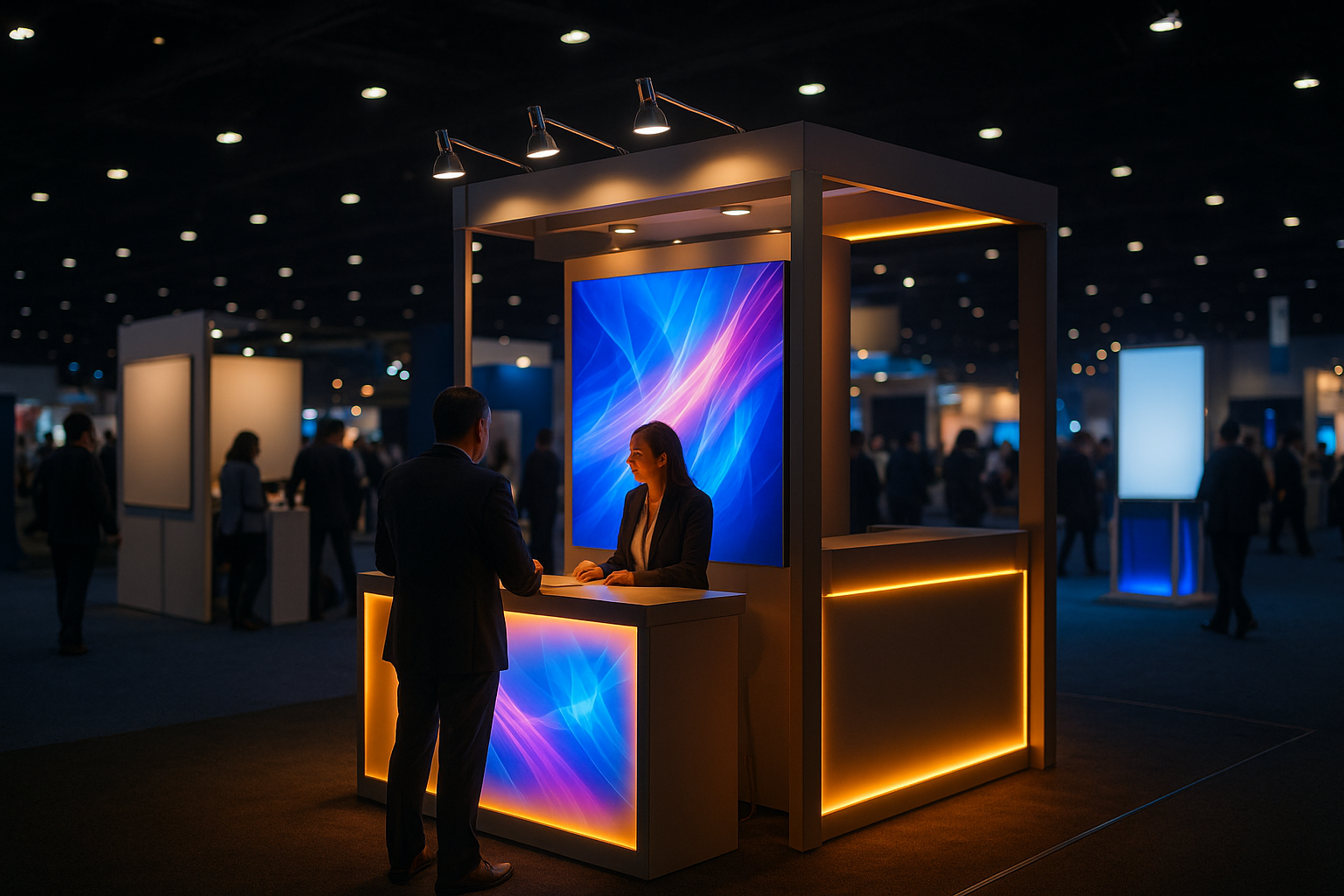Trade shows are crowded, competitive environments where dozens or even hundreds of exhibitors fight for attention. Your booth may have great signage, creative graphics, and a strong team, but without the right lighting strategy your display can easily blend into the background. Lighting is more than a finishing touch. It is one of the most powerful tools for creating impact, guiding visitor attention, and shaping how your brand is perceived.
This article explores why lighting matters, the types of trade show lighting you can use, and lighting tips for trade show displays that shine brighter than the competition.
Why Lighting Matters in Trade Show Displays
Lighting is often underestimated during booth planning. Exhibitors may assume that the ambient lighting provided by the convention center is enough, but relying on venue lighting alone is a mistake. Strategic lighting design can:
- Increase visibility: A well-lit booth stands out across the exhibit floor, making it easier to draw attendees from a distance.
- Highlight products: Focused lighting allows you to emphasize key items, new launches, or featured areas within your booth.
- Set the mood: Color temperature, brightness, and style of lighting create an atmosphere that influences how visitors feel in your space.
- Build professionalism: Poor or uneven lighting can make a display look unfinished, while thoughtful lighting instantly elevates your brand image.
Types of Lighting for Trade Show Displays
1. Overhead Spotlights
Spotlights are ideal for directing attention to products, graphics, or demo areas. They create contrast and help prevent important elements from being lost in a sea of visuals. Adjustable spotlights let you refine focus depending on the booth layout.
2. Backlit Graphics
Lightbox displays and SEG (silicone edge graphics) systems use LED backlighting to make graphics glow from within. Backlit visuals appear sharper, more vibrant, and more memorable compared to standard printed panels.
3. Accent Lighting
Accent lighting adds depth and drama to your booth. Strips of LED lights placed along counters, shelves, or display edges create a polished and modern effect. Accent lighting is also excellent for small booths where space is limited but impact is needed.
4. Colored Lighting
Colored LED washes or uplighting allow you to infuse your booth with brand colors or adjust the mood depending on the event. Warm tones create a welcoming feel, while cool tones feel modern and futuristic. The key is subtlety. Too much color can be overwhelming, so use sparingly.
5. Task Lighting
Task lighting is practical rather than decorative. This includes under-counter lighting, small lamps, or specific fixtures that ensure your staff can demo products, take notes, or interact with visitors without straining their eyes.
Best Practices for Using Lighting Effectively
- Layer your lighting: Combine general lighting, accent lighting, and spotlights for dimension rather than relying on a single source.
- Keep it consistent with your brand: Choose lighting colors and styles that align with your logo, design theme, and message.
- Mind the brightness: Too much light can create glare or discomfort, while too little makes your booth hard to see. Aim for balance.
- Highlight focal points: Decide what you want visitors to notice first and direct your brightest lights there.
- Test in advance: Lighting may look different in a trade show hall compared to a studio. Test setups before the event whenever possible.
- Stay energy efficient: Modern LED lighting consumes less energy, generates less heat, and reduces costs compared to older fixtures.
Lighting on a Budget
Lighting does not have to be expensive to be effective. Simple upgrades can make a big difference. Portable LED spotlights, affordable clamp lights, or reusable light strips can all boost your booth without requiring a large investment. Renting lighting equipment is also an option if you only exhibit a few times per year.
Future Trends in Trade Show Lighting
As technology evolves, lighting is becoming more interactive and customizable. Programmable LED systems allow exhibitors to change colors, brightness, and effects in real time. Integration with digital displays can sync lighting with on-screen content for a coordinated experience. Even simple automation, like dimming lights during presentations and brightening them afterward, can add polish to your booth.
How Digital Arts Imaging Can Help
At Digital Arts Imaging, we specialize in creating trade show displays that combine strong visuals with high-quality presentation. Our SEG light boxes and backlit displays are designed to ensure your graphics do not just hang on a wall but actually glow with professional brilliance. We offer modular display systems, custom graphics, and event signage that integrate seamlessly with modern lighting strategies.
Whether you need a full trade show booth designed from the ground up or want to add backlit graphics to your existing setup, our team can deliver solutions that are visually stunning, easy to set up, and reusable across multiple shows. By pairing your brand message with thoughtful lighting and impactful graphics, we make sure your booth shines brighter than the competition.
Conclusion
Lighting is one of the most overlooked aspects of trade show planning, yet it has a tremendous impact on how visitors experience your booth. The right lighting helps you stand out, supports your message, and creates a more professional and engaging atmosphere. Whether you use simple spotlights or invest in backlit graphics and accent features, thoughtful lighting design ensures that your trade show display does exactly what it should: attract attention and leave a lasting impression.
For more information, visit our other blogs.

